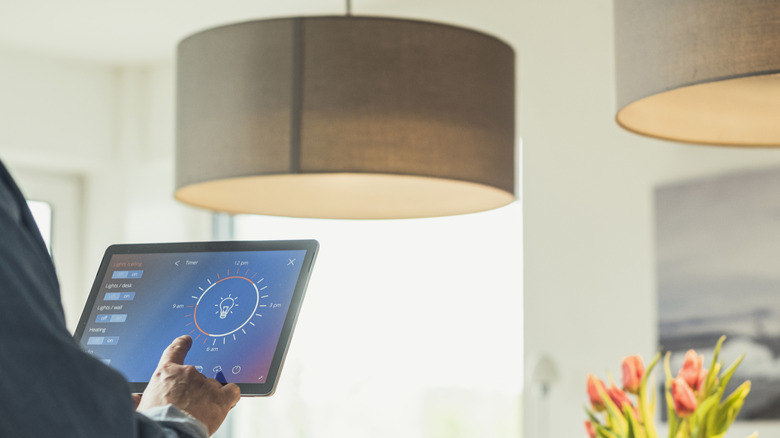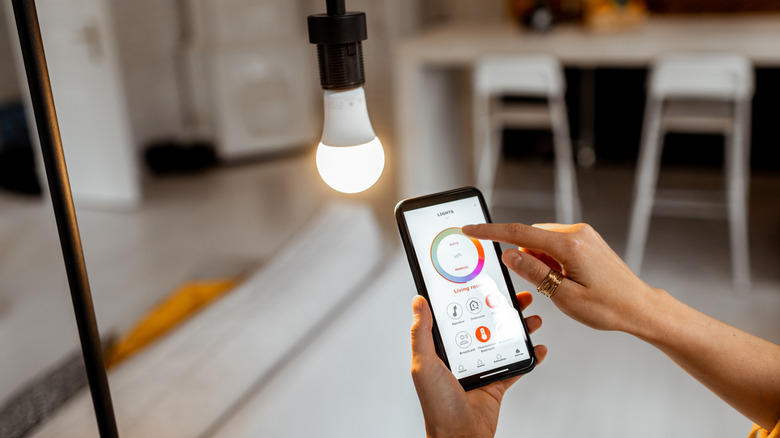Do Smart Bulbs Work With Regular And Dimmer Light Switches?
Our homes are becoming increasingly smart, and at the heart of these intelligent setups is the unassuming light bulb. For those of us who have them, these smart bulbs have changed the way we light our homes, allowing us to control our home's lighting through an app on our phone, a voice assistant like Alexa on the Amazon Echo, or even automation, like programming the lights to turn on at sunset or off when we leave the house. From changing brightness and color temperature to setting schedules and controlling lights remotely, smart bulbs seemingly do it all.
This convenience is what has made smart bulbs such a popular choice when it comes time to upgrade home lighting systems. But all of these features rely on one important factor: uninterrupted power. That can become an issue when smart bulbs are paired with traditional or dimmer light switches, which weren't designed with smart functionality in mind. However, as long as you keep your traditional switch in the on position, or your dimmer switch dialed to the maximum, your smart bulb should work fine.
Smart bulbs require constant power to function properly
Chances are you have quite a few light switches strategically placed around your home. After all, most homes use standard wall switches to control lighting. However, the proliferation of smart bulbs in recent years is changing how many of us control the lighting in our homes. Before investing in these intelligent bulbs, it's a good idea to do your research and get to know the major smart lighting brands and how they stack up against the competition. Once you've done that, it's time to figure out how they'll work with the current lighting setup you have in your home. What makes smart bulbs so attractive is that all of their features make it so much easier for us to control our lighting, whether we're at home or away, without ever needing to touch a light switch.
Of course, all of these features make it so that smart bulbs require a steady flow of electricity, something that can become a problem when they're paired with a traditional wall switch. That's because when you turn off a regular switch that's connected to a smart bulb, you effectively cut off the bulb's connection to your smart home system, rendering it unresponsive to app commands, voice control, and any automated routines you've set up — it'll still work, just not the way you want. For example, you flip a regular wall switch off out of habit, only to realize your app can't turn the light back on until you flip the switch again. While this is inconvenient, especially if you're not at home, it's a common issue you can avoid by keeping the regular light switch in the on position and using your app or voice assistant to control the light instead.
Why traditional dimmers cause trouble for smart bulbs
There are a few things you should know before buying and installing smart bulbs in your home, including how they work with traditional switches. Since most homes still use standard wall switches or built-in dimmers, integrating smart bulbs into this setup can be problematic. It gets even more complicated with dimmer switches because the way they change voltage to reduce brightness can interfere with the smart bulb's internal electronics. The bottom line is that most smart bulbs aren't compatible with dimmer switches.
Smart bulbs come equipped with their own internal dimming controls, so when you connect them to a fixture with a traditional dimmer, a conflict can arise between the two systems. If you try to use a smart bulb with a dimmer switch, you may experience issues like flickering, buzzing, strobing, and, in the worst-case scenario, long-term damage. To avoid these potential problems, don't try to control the brightness of the bulb using the dimmer switch. Another alternative is to only use smart bulbs with regular switches or those rated for use with smart bulbs.


